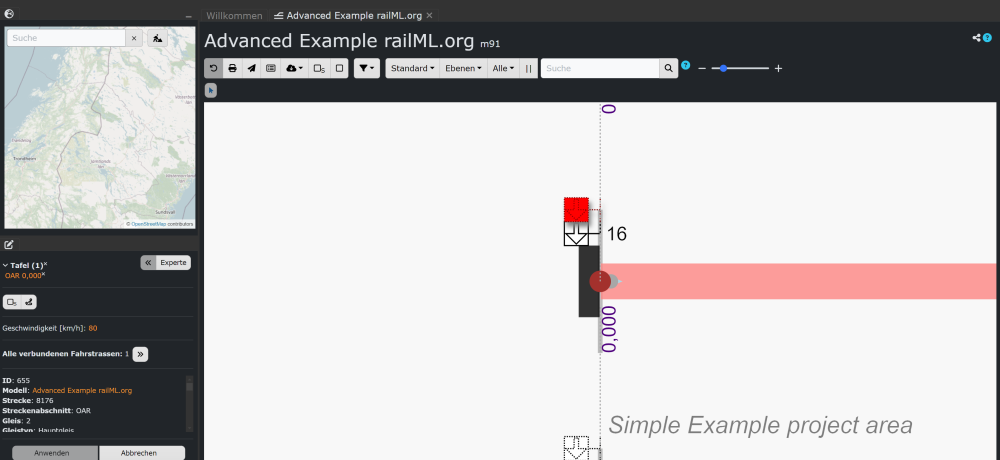Introduction
Documentation
Syntax
|
|
| Documentation
|
child element for construction details of the (physical) signal
|
| Subschema
|
infrastructure
|
| Parents*
|
signalIS
|
| Children
|
None
|
Attributes:
- height: height of the main light point (or upper edge for semaphore/panel signals) above the upper edge of the associated (or possibly next track) in [m] (optional;
xs:decimal),
- mountedOn: Describes how the signal is fixed in place (optional;
xs:string; patterns: other:w{2,}; consider Dev:UsingAny too.)
- Possible values:
- bufferStop: The signal (typically a board like ETCS- Stop Marker borad) is mounted on a buffer stop that terminates a dead end track.
- gantry: The signal is mounted above the track
- ground: The signal is mounted on the ground
- pole: The signal is mounted on a pole along the track
- wall: The signal is mounted on a wall,
- positionAtTrack: position of the (physical) signal/panel in relation to the railway track where it belongs to and the signal/panel application direction (optional;
xs:string)
- Possible values:
- above: signal is above the track
- left: signal is to the left of the track according to its application direction
- right: signal is to the right of the track according to its application direction,
- type: distinguish between light, form and virtual signals (optional;
xs:string)
- Possible values:
- board: a board is a panel that expresses one (unchangeable) signal aspect
- light: a signal with lamps
- semaphore: a signal, where the signal aspect is expressed by the position of its movable arms
- virtual: signal has no physical presence on the track. Command is passed in some other way, e.g. radio
|
*Notice:
Elements may have different parent elements. As a consequence they may be used in different contexts.
Please, consider this as well as a user of this Wiki as when developing this documentation further.
Aspects that are only relevant with respect to one of several parents should be explained exclusively in the documentation of the respective parent element.
|
|
|
| Documentation
|
child element for construction details of the (physical) signal
|
| Subschema
|
infrastructure
|
| Parents*
|
signalIS
|
| Children
|
None
|
Attributes:
- height: height of the main light point (or upper edge for semaphore/panel signals) above the upper edge of the associated (or possibly next track) in [m] (optional;
xs:decimal),
- positionAtTrack: position of the (physical) signal/panel in relation to the railway track where it belongs to and the signal/panel application direction (optional;
xs:string)
- Possible values:
- above: signal is above the track
- left: signal is to the left of the track according to its application direction
- right: signal is to the right of the track according to its application direction,
- type: distinguish between light, form and virtual signals (optional;
xs:string)
- Possible values:
- board: a board is a panel that expresses one (unchangeable) signal aspect
- light: a signal with lamps
- pole: the signal aspect is expressed via a color code painted on the pole
- semaphore: a signal, where the signal aspect is expressed by the position of its movable arms
- virtual: signal has no physical presence on the track. Command is passed in some other way, e.g. radio
|
*Notice:
Elements may have different parent elements. As a consequence they may be used in different contexts.
Please, consider this as well as a user of this Wiki as when developing this documentation further.
Aspects that are only relevant with respect to one of several parents should be explained exclusively in the documentation of the respective parent element.
|
|
|
| Documentation
|
child element for construction details of the (physical) signal
|
| Subschema
|
infrastructure
|
| Parents*
|
signalIS
|
| Children
|
None
|
Attributes:
- height: height of the (physical) signal/panel, in [m] (optional;
xs:decimal),
- positionAtTrack: position of the (physical) signal/panel in relation to the railway track where it belongs to and the signal/panel application direction (optional;
xs:string)
- Possible values:
- type: distinguish between light, form and virtual signals (optional;
xs:string)
- Possible values:
- pole: the signal aspect is expressed via a color code painted on the pole
- board: a board is a panel that expresses one (unchangeable) signal aspect
- virtual: the signal does not exist physically as infrastructure component, but only virtually
- semaphore: a signal, where the signal aspect is expressed by the position of its movable arms
- light: a signal with lamps
|
*Notice:
Elements may have different parent elements. As a consequence they may be used in different contexts.
Please, consider this as well as a user of this Wiki as when developing this documentation further.
Aspects that are only relevant with respect to one of several parents should be explained exclusively in the documentation of the respective parent element.
|
Changes 3.1→3.2
There exists an overview of all changes between railML® 3.1 and railML® 3.2 on page Dev:Changes/3.2.
The parents have been changed.
The attributes have been changed.
Changes 3.2→3.3
There exists an overview of all changes between railML® 3.2 and railML® 3.3 on page Dev:Changes/3.3.
The parents have been changed.
The attributes have been changed.
Semantics
Best Practice / Examples
Real life example of the @type = "virtual" is a (marker) board that is placed at a buffer stop meaning end of route. In the railML 3.3 interlocking subschema it will be implemented with signalIL\@function="trackEnd".
Additional Information
Notes
Open Issues

